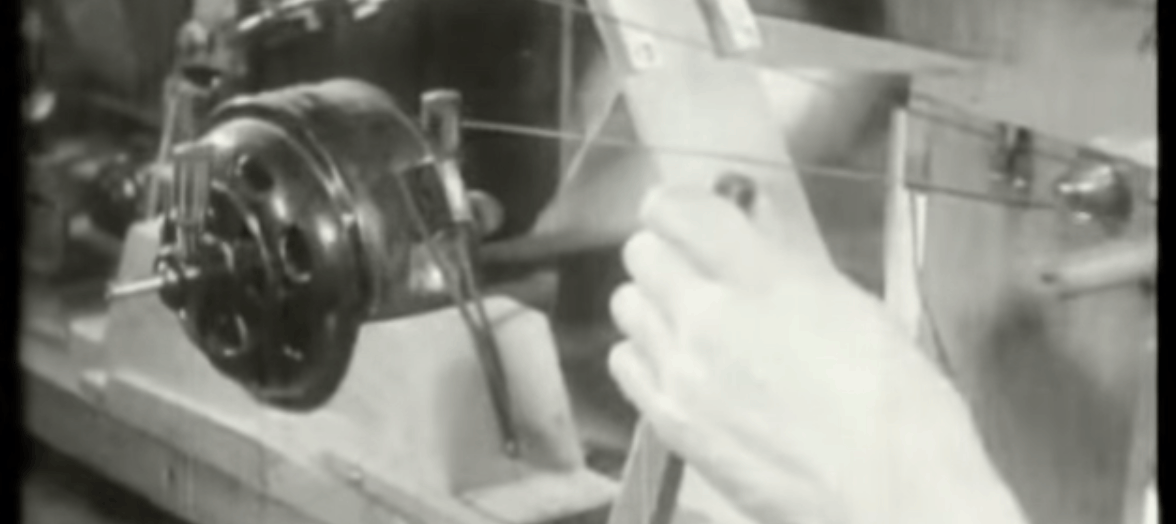

Here’s a story of chance: A young Russian man in the early years of the Soviet Union invents a new way to create music by using electronics in an unexpected way. This new instrument is mostly a curiosity, although it does see some use in movie soundtracks. By the end of the Second World War, however, it falls out of favor–but it lives on in spirit within the first generations of analogue synthesizers that emerge in the 1960s.
This is the story of Léon Theremin, but it’s also the story of Evgeny Sholpo. Theremin invented an instrument named after himself–the theremin is still played today and occupies an important role in the history of electronic music in the 20th century. Sholpo invented the Variophone, a footnote by comparison.
That isn’t to say that the Variophone doesn’t deserve more attention. It was effectively a way of hacking electronic music onto 35mm film in the early 20th century–Sholpo cut waveform shapes into cardboard discs, and rotated them while shining light through the holes onto film moving past at the same speed, creating a “soundtrack” that a primitive loudspeaker could then replay. It was even possible to layer sounds, with up to 12 “voices” per filmstrip. Sholpo used the Variophone to produce soundtracks for Soviet movies throughout the 1930s.
And, to modern ears, it sounds like 8-bit video game music from half a century later:
But it was a clunky, slow way to record music, and the last known operational Variophone was destroyed during the Siege of Leningrad in 1941. Sholpo died before he could build a new one and his institute, dedicated to “graphical sound,” closed only a year after it opened.
The theremin, of course, eventually made its name as the instrument of choice for Hollywood horror films, giving it a niche (and some might even say kitschy) appeal that sustained the instrument long enough to influence the development of more complex synthesizers in the 1960s. Robert Moog, who built the first commercially successful transistor synth, started as a theremin enthusiast and manufacturer.
While Sholpo wasn’t the only artist or engineer interested in combining light and sound–in either the Soviet Union or the rest of the world–it’s fascinating to look back at his life and consider why some experimental ways of making music succeed in becoming popular, and others don’t. Is it their tone? Their pitch? Their physicality? Their practicality?
Here’s one possibility–popular instruments earn their reputation because they’re used in popular music. “It was quite surprising that this was the only factor to predict success,” explains Anna Wolf, a music psychologist working as part of a team from the Hanover University of Music, Drama, and Media that’s investigating why some instruments fail to enter mainstream musical language, while others succeed.
The work, a collaboration between between Wolf, Reinhard Kopiez (also of the Hanover University of Music, Drama and Media), and Christoph Reuter (University of Vienna) was driven by “a passion for weird, successful, and unsuccessful instruments invented over the years,” Wolf told me. As a result, the team “started building a matrix with instruments, and all the possible variables to describe them–when they were invented, if the technique to play them is unconventional, the range of pitches you can produce, and so on.”
There are more than 20 variables for each instrument in the database, and the 30 or so instruments include such delights as:
- The Trautonium (1930): A kind of keyboardless electric piano whose keys were replaced with a long wire. Only 13 were ever sold before it was discontinued, but the instrument retained cult appeal with a very select number of composers–including Oskar Sala, who used it to create the avian noises in The Birds.
- The Ondes Martenot (1928): A curious proto-synth that can mimic a range of classical instruments using vibrations in vacuum tubing, it’s almost exclusively used by film composers–appearing in soundtracks for movies such as Lawrence of Arabia and There Will Be Blood.
- The Rhythmicon (1930): The first instrument that could conceivably be called a drum machine, it was created by Léon Theremin at the request of avant-garde musician Henry Cowell. Cowell believed he had written percussive scores that were impossible for a human to play otherwise.
- “¦ and the Sphäraphon (1924): It’s just one of a number of instruments based on radio technology that could produce notes outside of the standard tonal range.
When the researchers looked for traits among these instruments and others in the data set that correlated with both success and failure, there was one that connected them all: The successful instruments had all been played by popular musicians or composers, and featured in popular forms of music. (“Success,” said Wolf, was defined as “still being able to buy it 10 or 20 years after it was first produced.”)
So, popular instruments are popular because well-known musicians find them and use them in their work. “It’s almost too easy, too believable,” Wolf admitted.
This conclusion, however, applied just to a first batch of instruments from before the Second World War. She stressed that the team plans to keep building out the database to include instruments from throughout the 20th century, up to modern day, to verify the pattern. “We want to collect info for maybe a hundred instruments,” Wolf said.
But if it holds, maybe there’s a simple trick for anyone out there hoping to score big with a homemade instrument–get it into the hands (and the studio) of a big star. That could well be the difference between a Léon Theremin and an Evgeny Sholpo.


How We Get To Next was a magazine that explored the future of science, technology, and culture from 2014 to 2019. This article is part of our Fast Forward section, which examines the relationship between music and innovation. Click the logo to read more.
